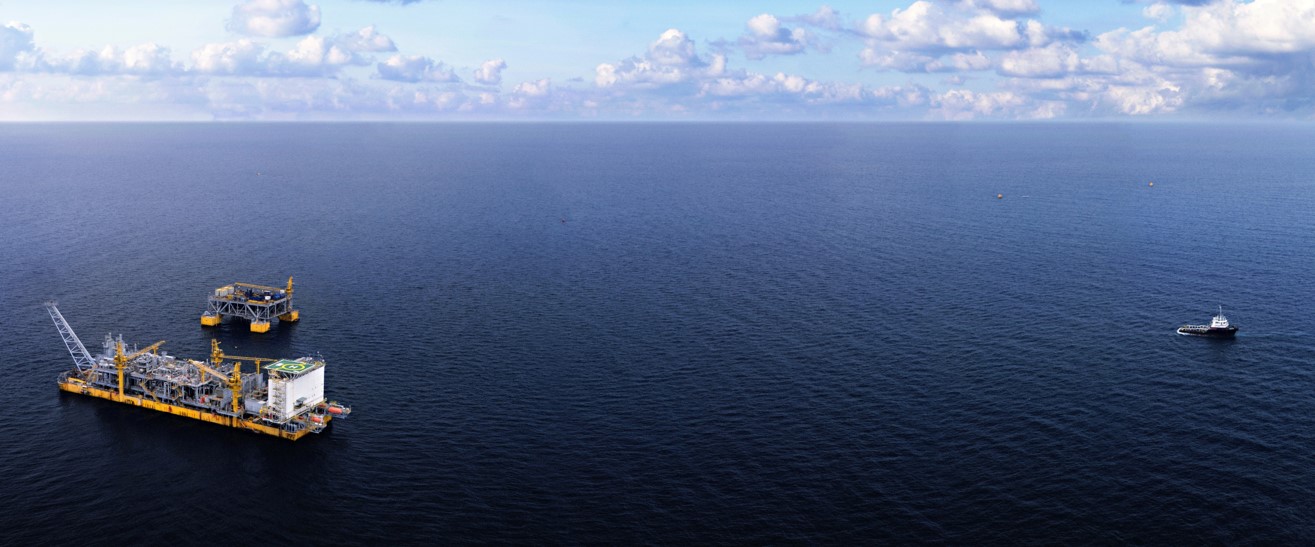siaran pers Chevron Umumkan Gas Pertama Proyek Bangka Di Kalimantan Timur, Indonesia

Fasiilitas produksi terapung di Lapangan Bangka, lepas pantai Kalimantan Timur, Indonesia.
Jakarta, Indonesia, 31 Agustus 2016 - Chevron Indonesia Company Ltd. mengumumkan hari ini bahwa Proyek Pengembangan Lapangan Bangka telah mencapai produksi gas alam pertamanya, yang merupakan tahap pertama dari Proyek Indonesia Deepwater Development (IDD) Chevron di Kalimantan Timur.
“Gas pertama Proyek Bangka ini merupakan pencapaian penting dan perwujudan komitmen Chevron untuk terus mendukung pencapaian target energi pemerintah dan menghasilkan energi secara selamat, efisien, dan andal bagi Indonesia,” kata Chuck Taylor, Managing Director Chevron IndoAsia Business Unit.
“Proyek ini menunjukkan komitmen Chevron untuk membawa kemampuan global dan teknologi terkini bagi Indonesia serta menerapkan praktik terbaik dan keahlian dari proyek-proyek pengembangan laut dalam kami di seluruh dunia,” tambahnya.
Proyek Bangka memiliki kapasitas terpasang sebesar 110 juta kaki kubik gas dan 4.000 barel kondensat per hari. Chevron memegang 62 persen saham kepemilikan di Proyek Bangka dengan mitra joint venture lainnya yaitu eni dengan kepemilikan sebesar 20 persen dan Tip Top sebesar 18 persen. Persetujuan pemerintah untuk keputusan final investasi atau Final Investment Decision (FID) dicapai pada tahun 2014. Chevron memulai kegiatan pengeboran sumur pada semester kedua 2014.
Taylor juga menjelaskan, “Selama lebih dari 90 tahun, Chevron telah menjadi mitra utama dalam memenuhi kebutuhan energi Indonesia, menggerakkan pertumbuhan ekonomi, dan mendukung pengembangan masyarakat di Kalimantan Timur dan wilayah operasi kami lainnya.”
Chevron adalah salah satu perusahaan energi terintegrasi dunia terdepan dan melalui unit usahanya di Indonesia, telah beroperasi di negeri ini selama 92 tahun. Dengan inovasi dan komitmen karyawan kami yang sangat terampil dan berdedikasi, Chevron Indonesia menjadi salah satu produsen minyak mentah terbesar di Indonesia. Dari lapangan-lapangan minyak darat kami di Riau, Sumatera dan lapangan-lapangan lepas pantai di Kalimantan Timur, kami telah memproduksi lebih dari 12 miliar barel minyak demi memenuhi kebutuhan energi untuk pertumbuhan ekonomi Indonesia. Dalam mengoperasikan blok migas, Chevron bersama para mitra joint venture bekerja di bawah pengawasan dan pengendalian SKK Migas berdasarkan kontrak bagi hasil atau Production Sharing Contract (PSC). Lebih dari itu, Chevron juga merupakan salah satu produsen panasbumi terdepan di Indonesia dengan dua operasi panasbumi di Jawa Barat, yaitu Darajat dan Salak. Informasi lebih lanjut mengenai Chevron di Indonesia dapat diakses melalui indonesia.chevron.com.
Contact:
Danya Dewanti
email:danya.dewanti@chevron.com
phone:+62811894229
NOTICE
CAUTIONARY STATEMENT RELEVANT TO FORWARD-LOOKING INFORMATION FOR THE PURPOSE OF “SAFE HARBOR” PROVISIONS OF THE PRIVATE SECURITIES LITIGATION REFORM ACT OF 1995
This press release contains forward-looking statements relating to Chevron’s operations that are based on management’s current expectations, estimates and projections about the petroleum, chemicals and other energy-related industries. Words or phrases such as “anticipates,” “expects,” “intends,” “plans,” “targets,” “forecasts,” “projects,” “believes,” “seeks,” “schedules,” “estimates,” “positions,” “pursues,” “may,” “could,” “should,” “budgets,” “outlook,” “trends,” “guidance,” “focus,” “on schedule,” “on track,” “goals,” “objectives,” “strategies,” “opportunities” and similar expressions are intended to identify such forward-looking statements. These statements are not guarantees of future performance and are subject to certain risks, uncertainties and other factors, many of which are beyond the company’s control and are difficult to predict. Therefore, actual outcomes and results may differ materially from what is expressed or forecasted in such forward-looking statements. The reader should not place undue reliance on these forward-looking statements, which speak only as of the date of this release. Unless legally required, Chevron undertakes no obligation to update publicly any forward-looking statements, whether as a result of new information, future events or otherwise. Among the important factors that could cause actual results to differ materially from those in the forward-looking statements are: changing crude oil and natural gas prices; changing refining, marketing and chemicals margins; the company's ability to realize anticipated cost savings and expenditure reductions; actions of competitors or regulators; timing of exploration expenses; timing of crude oil liftings; the competitiveness of alternate-energy sources or product substitutes; technological developments; the results of operations and financial condition of the company's suppliers, vendors, partners and equity affiliates, particularly during extended periods of low prices for crude oil and natural gas; the inability or failure of the company’s joint-venture partners to fund their share of operations and development activities; the potential failure to achieve expected net production from existing and future crude oil and natural gas development projects; potential delays in the development, construction or start-up of planned projects; the potential disruption or interruption of the company’s operations due to war, accidents, political events, civil unrest, severe weather, cyber threats and terrorist acts, crude oil production quotas or other actions that might be imposed by the Organization of Petroleum Exporting Countries, or other natural or human causes beyond its control; changing economic, regulatory and political environments in the various countries in which the company operates; general domestic and international economic and political conditions; the potential liability for remedial actions or assessments under existing or future environmental regulations and litigation; significant operational, investment or product changes required by existing or future environmental statutes and regulations, including international agreements and national or regional legislation and regulatory measures to limit or reduce greenhouse gas emissions; the potential liability resulting from other pending or future litigation; the company’s future acquisition or disposition of assets or shares or the delay or failure of such transactions to close based on required closing conditions; the potential for gains and losses from asset dispositions or impairments; government-mandated sales, divestitures, recapitalizations, industry-specific taxes, changes in fiscal terms or restrictions on scope of company operations; foreign currency movements compared with the U.S. dollar; material reductions in corporate liquidity and access to debt markets; the effects of changed accounting rules under generally accepted accounting principles promulgated by rule-setting bodies; the company's ability to identify and mitigate the risks and hazards inherent in operating in the global energy industry; and the factors set forth under the heading “Risk Factors” on pages 20 through 22 of Chevron’s 2016 Annual Report on Form 10-K. Other unpredictable or unknown factors not discussed in this press release could also have material adverse effects on forward-looking statements.